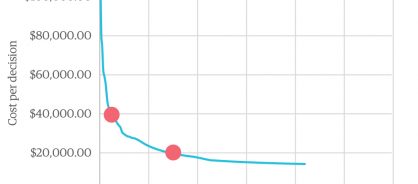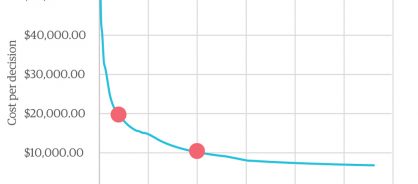- Point of view
Optimizing analytics for competitive advantage: Part 1 – The cost of insight

Enterprises make critical business decisions every day in areas such as growth strategy, resource planning, and capital allocation. Making the right decision at the right time can be the difference between success and failure in our ever-changing world. Though many leaders have great instincts, just one bad decision can have serious consequences. To gain a competitive advantage, many businesses are moving away from traditional methods of decision-making that can be influenced by human bias toward more data-driven decision-making. Combining the power of data, advanced analytics, machine intelligence, and human judgment – also known as augmented intelligence – empowers the enterprise to make more informed decisions.
Based on the average number of decisions made each year by Fortune 500 companies – and the associated costs – an unoptimized data-driven decision can cost anywhere from $20,000–$40,000 (figure 1), according to Genpact. In a world where budgets are increasingly tight, this cost is too big to ignore.
Figure 1: Unoptimized decision-making

To analyze the cost of a decision, we combine the cost of insight with the cost of action. The cost of insight is the cost of ingesting and managing data to develop reporting and analytics solutions. The cost of action is the data consumption spend, which includes developing smart workflows and intelligent processes to augment business processes and generate business value.
Here, we'll focus on the cost of insight – namely, how to identify and minimize the cost drivers.
Calculating the cost of insight
Businesses often prioritize initiatives based on cost and the associated business value. Though many of the decisions made before COVID-19 hit are no longer relevant, businesses want transparency on how analytics can help navigate a new normal before investing.
For example, an increasing number of COVID-19 cases had impacted plant operations at a global manufacturer. Despite the growing risk, the manufacturer needed to understand how operational analytics could help them resolve the problem before seeking the necessary approvals for a new analytics solution. To provide this view, you need to understand how much you currently spend on analytics.
Unfortunately, most organizations have limited visibility into their analytics spending because costs disperse across different areas. But when the four factors that contribute to the cost of insight – discovery, ingestion, management, and consumption – pull together, the costs can be staggering (table 1). Based on our analysis, the overall cost of insight accounts for 12–25% of IT spend.
Table 1: Factors that contribute to the cost of insight

These costs can quickly spiral out of control, and as budgets tighten, there is more urgency for enterprises to control the cost of insight. When you've identified where the costs lie, this is how to optimize them:
Optimizing the cost of insight
Based on our work helping leading enterprises make faster, better, and more cost-effective data-driven decisions, we've identified four ways to optimize the cost of insight.
1. Data discovery: harness the power of cloud technology
With modern, cloud-based data architectures, organizations can store and manage large volumes of data at a reduced cost – usually saving 15–20% when compared to traditional storage methods. Cloud also allows businesses to structure, query, and process data at speed and scale. With a cloud strategy that combines deep industry, technology, data, and process expertise with the right partner ecosystem, you can significantly reduce the cost of insight.
With cloud, the sky's the limit: A leading investment and asset management firm was struggling to scale its existing on-premise technology platform to handle advanced analytics. By building a scalable cloud-based data hub and integrating data from various sources to reduce processing time, this solution reduced infrastructure costs by almost 50%. In our increasingly virtual world, every business must accelerate cloud adoption to realize greater business agility and innovation.
2. Data ingestion: connect data use to business priorities
You don't need to build the perfect data lake; you need to focus on the most valuable data. When working with large enterprises, we've seen that 80% of data-driven decisions made use just 20–30% of available data. Focus on data use cases that solve the most critical business problems to reduce overall data costs by 5–10%.
Focusing on what matters most: A medical devices company was struggling to establish a standardized view of their KPIs. To deliver reports to business leaders, employees would trawl through masses of data and pull metrics from disparate systems. By adopting a more targeted approach to data ingestion, the team delivered a fully automated dashboard visualizing 350+ KPIs within four months and saved the business 40% of its previous data ingestion costs.
3. Data management: carefully design a data management solution
Without a robust data management strategy, you risk compromising compliance, speed to market, and customer experience. According to Harvard Business Review, “More than 70% of employees have access to data they should not, and 80% of analysts' time is spent simply discovering and preparing data." [1]
So, how do you avoid this? When designing and implementing a data management solution, make sure it has the following features:
- Near real-time, traceable information with potential to reduce employee intervention by up to 10%
- A future-proof, trustworthy data foundation to prevent rework and accelerate the delivery of insights
- Reusable data and analytics assets to support future data and analytics solutions
- Short cycle times with the ability to experiment, which has potential to reduce forecasting and planning cycle times by up to 30%
Small changes lead to big benefits: A manufacturing company was struggling with data proliferation and an inefficient purchase requisition to purchase order process. By developing a new data management solution, it increased productivity and sourcing savings and reduced excess inventory. Overall, the company realized a 30% productivity increase in master data management operations and a 90% overall reduction in vendor cycle times.
4. Data consumption: create your analytics pod
Your ability to uncover insights at speed and scale is directly linked to the cost of insight – the faster and more useful the insight, the more justifiable the cost. Therefore, many enterprises are creating analytics pods, or teams, to increase the speed and scale of analytical insights.
If you're unfamiliar with analytics pods, here are some of their key components:
- A self-organizing team that can speak the languages of technology and business processes and in which every member takes responsibility for turning data hypotheses into actionable insights
- A collection of cross-functional skills necessary to create new analytical solutions
- Close collaboration with the business, including IT and end users, during solution development
- Focused on knowledge sharing across multiple pods so every area of the business can benefit
The power of the pod: A large health insurance company established an analytics pod to overcome its siloed analytics strategy. In just 11 months, eight employees with bilingual talent worked as analytics pods to develop eight new analytics solutions. These solutions cut medical costs and leakage and boosted care quality, with a total bottom-line impact of $150 million.
Getting started
By taking steps to minimize data discovery, ingestion, management, and consumption costs, organizations can reduce the cost of insight by 30–50% (figure 2). In summary, optimizing the cost of insight means you can increase the number of decisions you make while lowering the associated cost and gaining a competitive advantage.
Figure 2: Optimized decision-making

If you're at the very start of your analytics journey, here's how to lay the groundwork for optimizing the cost of insight:
- Set up an analytics transformation office to manage your analytics strategy and prioritize use cases
- Analyze your current infrastructure and plan your cloud strategy to support agile analytics
- Develop a strong data foundation that is future-proof, trustworthy, and optimized
- Establish a centralized analytics community and identify strategic partners to help you grow it
As we face a challenging economic landscape, businesses that can calculate and control the cost of insight will be those that make the right decisions at the right moments to thrive in the future.
Read part 2 of our data-driven decisions series, which explores how to calculate and optimize the cost of action.